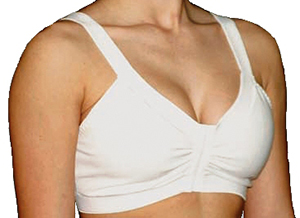Breast Reduction
-
 Medically Reviewed by Charlie Chen, MD | Last updated 10/18/2023
Medically Reviewed by Charlie Chen, MD | Last updated 10/18/2023 - Overview
Overview
What is breast reduction?
Do you feel your breasts are too large or heavy for the size of your body? If so, you may be a good candidate for breast reduction surgery.
For many women, reducing the size of overly large breasts not only increases their self-confidence but provides relief from physical issues such as shoulder, back, and neck pain which oftentimes interferes with normal, everyday activities.
The overall goal of breast reduction surgery is to leave the patient with smaller, lighter, and more proportionate breasts. In some cases, a breast reduction will be combined with a breast lift to provide a more youthful and perkier look.
Topics covered on this page
- Cost of breast reduction
- Is the cost covered by insurance?
- Are you a candidate?
- Things to know beforehand
- Procedure overview
- Recovery time
- When to expect results
- How long will results last?
- Tips for choosing a plastic surgeon
Cost of breast reduction
The average cost of breast reduction for aesthetic purpose is $5,913 according to the American Society of Plastic Surgeons (ASPS), however this is only the surgeon’s fee. There are several other factors that can affect the cost of your procedure. Here are some of the top factors that influence cost.
- Surgeon’s Fee: The experience and reputation of the plastic surgeon performing your procedure can affect the cost. Highly skilled and well-known surgeons often charge a premium for their services.
- Anesthesia: The administration of anesthesia involves the expertise of an anesthesiologist. The type of anesthesia used, the duration of the procedure, and the qualifications of the anesthesia provider influence the anesthesia fees. General anesthesia is typically more expensive than local anesthesia with sedation.
- Surgical Facility: The surgical facility where your breast reduction is being performed may impact the cost. These fees cover the usage of the operating room and other associated services. To ensure a safe experience, check to see if your surgical facility is certified by the Accreditation Associations for Ambulatory Health Care (AAAHC).
- Location: The cost of living and the average pricing for medical services in a particular area can affect the cost of your procedure. In general, urban areas tend to have higher procedure fees. If you want to get a rough idea of the prices for medical procedures in your local area, you can use the Healthcare Blue Book, which functions similarly to Kelley Blue Book for estimating car prices.
- Complexity of the Procedure: The intricacy of your procedure can affect the cost. If it involves significant reconstruction or additional procedures expect the breast reduction cost to be on the higher side
- Medical Care: The care provided before and after affects the overall cost. This includes preoperative consultations, medical tests, surgical garments, prescription medications, and follow-up appointments.
- Additional Procedures: You may incur extra costs if you’re considering having other procedures alongside your breast reduction such as a liposuction or tummy tuck surgery.
- Insurance: In certain cases, your breast reduction may be covered by insurance if it is deemed medically necessary. In these instances, insurance providers may cover a portion of the procedure. However, insurance coverage can vary, and specific criteria must be met to qualify for coverage.
The total cost of breast reduction surgery can range from $5,000 to $12,000 or more without insurance. If you are considering breast reduction surgery, setup a consultation with a board-certified plastic surgeon. This will allow you to discuss your aesthetic goals and gain a thorough understanding of the specific cost breakdown and factors that pertain to your individual case.
Is the cost covered by insurance?
In certain situations, breast reduction surgery may be eligible for insurance coverage. Whether or not it qualifies for coverage depends on the specifics of your policy. Here are some factors that insurance companies usually take into account when deciding whether to provide coverage:
- Medical Necessity: Most insurance companies often require documented evidence showing the medical necessity of breast reduction. This usually involves demonstrating physical symptoms associated with having large breasts, such as chronic back, neck, or shoulder pain, skin irritation, or difficulties in physical activities.
- Unsuccessful Non-surgical Attempts: Insurance providers may ask for proof that you’ve attempted non-surgical approaches such as physical therapy, pain medications, or specialized bras, and that these attempts didn’t effectively relieve the symptoms related to having large breasts.
- Documentation and Pre-authorization: Prior approval from your insurance company is usually required before going ahead with surgery. This entails submitting detailed documentation from the plastic surgeon, outlining the patient’s symptoms, efforts made with non-surgical treatments, and the planned surgical procedure.
- Insurance Policies: Each insurance company establishes its unique set of policies when it comes to coverage.
If surgery is approved, insurance may cover a portion or all of the cost. It is common for patients to have some out-of-pocket expenses, such as deductibles, co-pays, or the portion of the cost not covered by insurance.
Is breast reduction right for you?

- In good overall health with no major medical issues
- Well informed about the procedure and what to expect
- Emotionally stable
- Experiencing back, shoulder or neck pain associated with overly large breasts
- Having difficulty finding dresses or tops that fit
- Uncomfortable with your appearance because of the size of your breasts
You may not be a good candidate if you are:
- Unhealthy, or have medical issues making you unfit for the procedure
- Pregnant, breastfeeding or plan on having children in the future
- Not realistic about the expectations, particularly regarding the expected scars and recovery period
- History of irregular mammograms
- Obese
- Smoker
To see if you’re a candidate, schedule a consultation with a plastic surgeon. They can make the final decision on whether or not breast reduction is right for you.
Things to know beforehand
Before you choose to have breast reduction surgery, you should make sure you understand the procedure, potential outcomes, and risks that may be associated with the surgery and recovery process. Here are some things that patients who had breast reduction surgery wish they had known before having surgery:
- You might not be able to get the exact cup size you want. How much your breasts can be reduced depends on your size, breast composition, and goals. During your consultation, your plastic surgeon will help you determine the best plan and give you a realistic idea of what you can expect. Most breast reduction patients go down one to two cup sizes.
- You’ll get a breast lift, too. The procedure is actually a twofer: Your surgeon will remove excess tissue and skin to make your breasts smaller, and then move the nipples up in position to give them a lift.
- You’ll have scars, which is a common concern among patients. Fortunately, there are ways to reduce the appearance of scarring during and after surgery. Most scars generally fade within a year after surgery.
- There’s a chance you’ll have decreased nipple sensation. This is caused by disruption of the nerves that innervate the nipple. In some cases, women may experience increased nipple sensation that is caused by agitated nerves.
- It could affect your ability to breastfeed later. If you plan on breastfeeding, make sure to discuss this with your surgeon.
- Insurance might be a battle. Breast reduction may be considered a cosmetic technique by your insurance carrier, especially if only a small amount of tissue is removed.
- You want to make sure your breasts are done growing before having a reduction. Breast reductions are generally not recommended for teenagers, as the surgery can affect normal development. However, teenagers who rapidly develop large breasts may struggle with physical and psychological problems as a result.
- You may have to lose weight before undergoing surgery. Many surgeons will recommend that overweight women try to lose weight before a breast reduction surgery. In some cases, losing weight is associated with shrinking breast tissue, which could make the surgery unnecessary.
- Your breasts won’t be perky forever. Breast reduction surgery can provide a lift, but as recovery progresses your breasts will fall somewhat. In addition, as you age your breasts will drop somewhat
- You might need to buy new clothing. Breast reduction surgery may affect how your clothing fits.
Procedure overview
The breast reduction surgical technique may vary depending on the patient’s anatomy, desired results, and the plastic surgeon’s preference. Here is a general overview of how a breast reduction procedure is performed:
- Anesthesia: You will be given general anesthesia to ensure you will be asleep and pain-free during the procedure.
- Incisions: The surgeon will make incisions typically around the areola and extending vertically down to the crease beneath the breast (known as the vertical or lollipop incision). In some cases, an additional horizontal incision along the breast crease (known as the anchor or inverted T incision) may be required for more extensive reductions.
- Tissue Removal & Reshaping: Next, the surgeon will remove excess tissue, fat, and skin. The remaining breast tissue is then reshaped to create a more lifted breast contour.
- Nipple & Areola Repositioning: In most cases, the nipple and areola are re-positioned to a higher location. They are carefully reattached to maintain sensitivity.
- Incision Closure: After the desired reshaping and tissue removal the incisions are closed. The incisions are typically layered and closed with dissolvable or removable sutures.
- Dressings & Garments: The surgeon will apply dressings or bandages to protect the incisions and may also use a surgical bra to provide support and minimize swelling.
After the surgery, you will be taken to a recovery area as you wake up from anesthesia.
Recovery time

Breast reduction compression garment photo courtesy of www.NouvelleInc.com
The overall recovery time associated with breast reduction surgery is typically 3-6 weeks. It is imperative that you carefully follow all instructions provided to you by your surgeon in order to minimize the risk for complications.
When to expect results
Approximately 2-3 months after your surgery you will be able to see your results, but subtle changes may continue to occur for up to one year.
If you have any questions or concerns throughout your recovery, make sure to contact your plastic surgeon.
How long will results last?
Generally speaking, breast reduction surgery results are permanent. Weight gain and pregnancy will lead to increased breast size, and weight fluctuations may also affect their size and shape. As is the case with all women, your breasts will lose tone and elasticity as a consequence of normal aging.
Tips for choosing a plastic surgeon
It is important to carefully select your breast reduction surgeon. The surgeon you choose can significantly impact your surgical outcome and overall satisfaction. Find a plastic surgeon with extensive experience in performing breast reduction procedures. Also, make sure that they are board-certified and affiliated with one or more of the following organizations:
- The American Board of Plastic Surgery
- The American Society of Plastic Surgeons
- The Aesthetic Society
EnhanceMyself.com relies on sources such as professional medical organizations, government agencies, academic institutions, and peer-reviewed scientific journals to write it’s articles. Learn more about how we ensure our content is accurate, in-depth, and unbiased by reading our editorial guidelines.
*Medical Disclaimer: This website does not provide medical advice. Read more.

